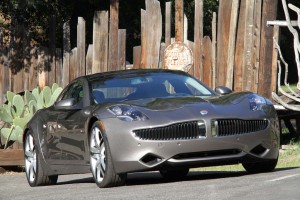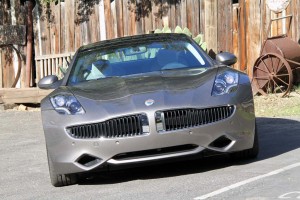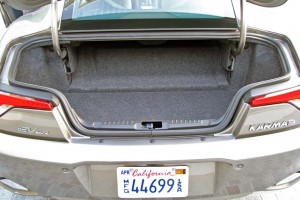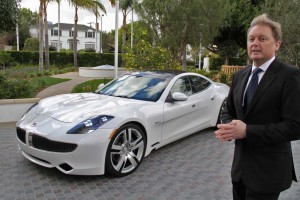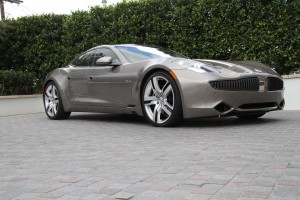If you want to go green expect to pay a significant penalty in terms of range, performance and price – or so goes the conventional wisdom. But when former Aston Martin designer Henrik Fisker set out to develop the eponymous Fisker Karma, nearly four years ago, he was determined to bring a high-styled, high-performance sports car to market “that would require no trade-offs.”
After a series of setbacks and delays, the first of his plug-in hybrids are beginning to roll into showrooms in the U.S. and Europe and production is steadily ramping up, the Finnish factory now turning out as many as 25 Karma sports cars a day. So we jumped at an offer to take one of the first of the 4-door plug-ins for a spin around Los Angeles, this week.
One thing is certain: Henrik Fisker hasn’t lost his touch as a designer. The new Karma is as pleasant to look at, and just as sexy, as one of the Sports Illustrated Swimsuit models. It’s sleek and modern, with a shape that seems to be in motion even when parked. During nearly 100 miles of driving we received frequent thumbs up from motorists pulling up alongside in everything from a beat-up Ford F-150 to a well-heeled Aston DB9 – ironically one of Fisker’s earlier projects.
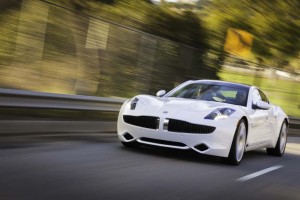
The Karma's battery drivetrain produces 400 hp and over 900 lb-ft of torque, enough to launch it to 60 in as little as 6.1 seconds.
But while it’s nice to have a truly sexy green machine — rather than a quirky, hyper-mile design like the Toyota Prius and Mitsubishi i, where aerodynamics trump styling – we stayed focused on the rest of the driving experience, aiming to see whether Fisker really has delivered a car that’s both exciting to own and drive and environmentally friendly.
The goal, the Danish-born Fisker told us as we headed for the highway, was to “deliver the best of both worlds. We wanted a car that made no excuses and offered no compromises.”
One might question that assertion considering the steady run-up in the Karma price tag, for one thing. At the current $102,000 it’s almost 20% more expensive than the California-based start-up originally promised. And, depending on whom you trust, the Fisker Karma either is or isn’t delivering on the high mileage and relatively long battery range first promised.
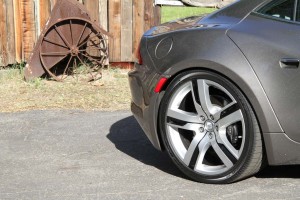
The good thing about having a stylist as your CEO: design matters, as such details as the Karma's standard 22-inch wheels illustrate.
The company long claimed Karma would deliver around 50 miles in “stealth,” or battery mode. But it took a hit from the EPA, earlier this year, which rated the range at only 32 miles and gave the hefty vehicle a meager 54 MPGe fuel economy rating. That figure is an equivalent balancing battery and gasoline modes. Operating on gas alone, the EPA said the Karma should get just 20 mpg.
While stung by the numbers it will be required to place on its window sticker, Fisker is quick to point to the results of European testing, regulators there being much more generous with an estimated 51 miles on battery power and a 112 MPGe estimate.
Which is true? Well, in part that depends on how you drive it. Both the U.S. EPA and European TUV results are based on test cycles far less aggressive than how we expect anyone buying a Fisker to drive. Despite its nearly 5,300 pounds, the Fisker Karma all but demands to be driven like a true sports car.
It certainly comes up with the other numbers that would suggest it can live up to those expectations. Combining the output of the two rear-mounted, 150 kilowatt electric motors you come up with 400 horsepower and about 980 pound-feet of torque. Fisker claims that will get you from 0 to 60 in as little as 6.1 seconds using both gas and electric power, or around 8 seconds on batteries alone. In Stealth mode the Karma has a rated top speed of 100 mph, a figure jumping to 125 mph when you switch to Sport mode.
(Fisker shifts to “Plan B” as alternative to government loan as it prepares second model, codenamed Project Nina. Click Here for that story.)
To power the two motors the Karma carries 20 kilowatt hours of lithium-ion nanophosphate batteries in a tunnel running right down the middle of the passenger compartment. Unlike the upcoming Prius plug-in hybrid, Fisker engineers opted for an extended-range electric vehicle approach – more like the Chevrolet Volt – in which the wheels can only be driven by electric power.
Once you run down the battery charge the Karma automatically switches on a turbocharged, 2.0-liter, 16-valve inline-four-cylinder gas engine – purchased from General Motors – that itself produces 260 hp and 260 lb-ft of torque. But the internal combustion engine is only onboard to serve as a generator either adding to the power provided by the batteries or substituting for the lithium-ion pack when it’s fully discharged.
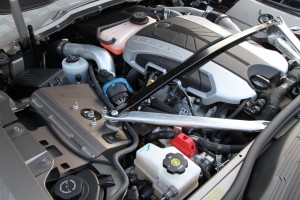
Once the battery pack runs down Karma keeps going using electricity generated by a GM-supplied, turbocharged 2.4-liter I-4 gas engine.
Additional power is generated – or, more accurately, regenerated – through the blended braking system. It’s capable of recapturing energy during stops as aggressive as 2.5 Gs – pumping as much as 100 kilowatts of power back into the battery. At higher speeds conventional friction brakes take over.
During our day driving around L.A. and the canyon’s north of Tinseltown we found the brakes were extremely effective, though there was a slight but noticeable transition point, during aggressive stops, when the friction brakes kicked in.
As with other current battery cars, Fisker engineers opted for a single speed gearbox, the motors pumping power into a 4:10 differential. As a result, launch feel was solid but the Karma didn’t quite deliver that sink-into-your seat feeling of a conventional, gas-powered sports car. “It’s like starting out in fourth gear,” suggested Bill Tally, Fisker’s chief of vehicle integration.
But once the Karma got moving it kept going, underscoring the benefit of a single-speed drivetrain. No pauses to shift and no jolts when changing gears.
One of the more curious discoveries was that if the Karma was “shifted” into Hill mode, designed to recapture energy more aggressively when coasting downhill, it also was a bit faster during aggressive launches. According to Tally, that’s because the battery voltage is running a little higher.
The 4-seat, 4-door sports car makes extensive use of advanced composites, plastics and aluminum to compensate for the massive battery pack it has to haul around. There’s no escaping the fact that this is a heavy car. Driving around the twisting tarmac cutting through Mulholland Canyon it brought to mind a big Bentley Continental rather than that Aston DB9.
But, like the Bentley, the Karma nonetheless proved surprisingly nimble, inspiring more and more confidence as we got familiar with the way it handled the turns. It helps to have that battery pack mounted low and amidship, rather than in a single lump near the nose or tail, as on some other electric vehicles.
Steering is quick and precise a fast gear ratio requiring minimal hand movement on even the tightest turns.
There are very definitely some compromises to its performance, but they are far less than we might have feared. For someone who wants a green machine that is more show than go, the Karma’s compromises are more than acceptable.
Of course, it helps to have a car that has been so lavishly and elegantly finished. The gauges are jewel-like and match the price tag. The finishes are refined and the seating supple yet supportive. In all, it’s the sort of interior we’d be happy to have in an Aston or even a Bentley.
Of course, that should be no surprise. Henrik Fisker is, first and foremost, a designer, and it shows everywhere you look, from the recurring diamond motif to the massive 22-inch wheels that his engineers claim to have been one of their biggest challenges.
Befitting the buyer Fisker is targeting, the Karma features interior materials that make minimal use of harmful chemicals, including the sort of chromium and lead found in many automotive leathers. The unlacquered wood even is sourced from either trees that sank to the bottom of Lake Michigan a century or two ago or from trees killed by recent California wildfires. And for those who want a truly “animal-free” interior, Fisker even offers a special edition that trades leather for materials like Alcantera.
(That new car smell could make you sick. Click Here for the story.)
Our one quibble is with the large video screen. It tended to wash out in bright sun and we’d prefer to have a few more actual switches rather than all the virtual controls that required us to poke through a series of levels to operate the climate control, audio and navigation systems. The controls also could be frustratingly slow when changing the speed of the heater fan, for example.
Some customers may also wonder about the odd hum the Karma emits at speeds under 25 mph – to us, something like a squadron of B-25 bombers approaching from a distance, though more high-tech colleagues suggested it was a lift from the movie, Tron. In fact, it’s Fisker’s way of meeting upcoming federal regulations that require vehicles operating in battery mode to make noise enough to be heard by pedestrians.
Is the Fisker Karma worth the money? For most folks, the answer would likely be no. At $102,000 this is an expensive automobile no matter what’s under the hood. And even if you were to trust the European, rather than EPA, mileage and range numbers it would be difficult to ever recover the price premium by lowering your energy costs.
But for those who want to go green while not having to settle for basic transportation – a Leonardo DiCaprio, say, who’d like something more lavish than his little Prius – the Fisker Karma clearly has its appeal. If the maker can ramp up production, avoid technical and quality issues and build word-of-mouth we expect it will be a must-have for those who are both environmentally minded and affluent enough to drive whatever they want.

